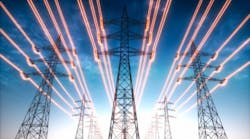By Mike Ting, senior product manager at Itron
Over the past year, the planet has faced dangerous and unprecedented climate disruption. Scorching temperatures, uncontrollable wildfires and hazardous energy blackouts are continuing to put the ecosystem and its inhabitants in grave danger. According to the National Weather Service, on one day in late June nearly half of the states in the US set or broke high temperature records, placing 30 million Americans under some type of heat advisory.
With the hottest months of the year upon us, the aging grid is struggling to keep up with energy demands resulting from these increasingly severe temperatures. A recent grid-reliability report found that power outages are very likely throughout this summer in parts of the Midwest, California and Texas. A long-term solution to avoiding these outages can be developed through a strategic demand-response (DR) program. DR programs leverage distributed-energy resources (DERs) such as air conditioning, electric-vehicle charging, solar inverters, and/or batteries to manage the equilibrium and cost of energy systems and ensure the continued reliability of the transmission and distribution grid.
Core principles of success
While the benefits of a DR program are clear, successful programs require thoughtful consideration across technology, program design, customer experience, and the utility’s longer-term strategies and objectives for reliability, customer engagement, resiliency and decarbonization. From our perspective as a long-time provider of DR programs and advanced-metering infrastructure, here are five core principles for successful DER management:
1. Solution architecture matters
Solution architecture is a key determinant of system latency and interoperability. Certain grid services like voltage and frequency regulation require total system latency (the time between the originating signal and the control) to be in the sub-second to sub-minute range. For DERs to provide advanced grid services with low latencies, a distributed computing or grid-intelligence architecture is needed.
In this distributed intelligence (DI) approach, smart meters that utilize embedded computing resources can perform complex processing. DI effectively moves grid analysis, decision making, and control to the grid’s edge, resulting in a significant reduction in latency of action, greatly improved situational awareness, more accurate analysis, and advanced event detection. Using smart endpoints such as meters, devices and other sensors with peer-to-peer connectivity, DI equips utilities with the foundation on which to cultivate both a modern grid and prolific customer relationships.
Distributed-energy resource-management systems must also integrate with a variety of utility systems, including advanced metering infrastructure, outage-management systems, customer-information systems, billing, and advanced distribution-management services. Especially given that these systems evolve over time, designing for interoperability is critical to a well-managed DER system.
2. Supporting customer choice
Both utility companies and customers play a critical role in the success of a DR program. For high customer satisfaction and retention, utility companies must make it easy for customers to onboard, connect and manage their own devices. Putting up barriers, particularly in a highly dynamic environment, is counter to success in the DER market—customer choice is essential. To this end, open standards play a key role in ensuring that customer-owned DERs can easily and efficiently be on-boarded and integrated into utility DR programs.
3. Security and high availability
While cybersecurity is a concern for any business, it is especially important for utilities. Given that behind-the-meter DERs are commonly connected through customer Wi-Fi networks (which aren’t typically secure), utility companies must proceed with caution.
On top of that, access to customer Wi-Fi can also be unreliable, creating availability issues. Tackling these hurdles means establishing alternative paths to DER connectivity. One particularly attractive alternative is connecting DERs to the utility AMI network, which adheres to industrial IoT standards, and provides high security as well as high availability. In certain circumstance, direct cellular connectivity also presents an attractive option for connecting behind-the-meter DERs as a means to establishing higher reliability of the flexible-load resource.
4. Convergence
Decisions should be made with the future state of the grid and utility systems in mind—especially in terms of convergence. Down the road, the legacy set of DR programs (i.e., thermostat programs, water-heater programs, large commercial and industrial programs) will become one large resource pool. Utilities should prioritize planning ahead to ensure a smooth convergence process for customers and utility operations alike.
5. Automation
Because of the low latencies required for certain grid services and resiliency outcomes, much (if not all) of the grid analysis, decision making, and control of DERs will require significantly higher levels of automation compared to those used in DR programs today. To that end, automation powered by artificial intelligence (AI) and machine learning (ML) will play an increasingly important role. Implementing AI and ML in utility operations and DER management is not simply a technology challenge, however. These AI and ML tools represent a significant change for DER program operators—one that will require institutional change, trust-building, and AI implementations that embrace transparency, auditability, and override in ways that are specifically tailored to utility operations.
As climate disruption continues to increase in severity, it is up to utility companies to ensure they are implementing the most innovative, efficient technologies to keep up with rising energy demands in a sustainable way. When utilities start formulating their strategy around DERs, they should begin with a proven resource: demand response. A successful DR program will provide the critical resources needed to mitigate the risks of blackouts, save consumers money, and ultimately foster a more reliable and sustainable energy grid.



